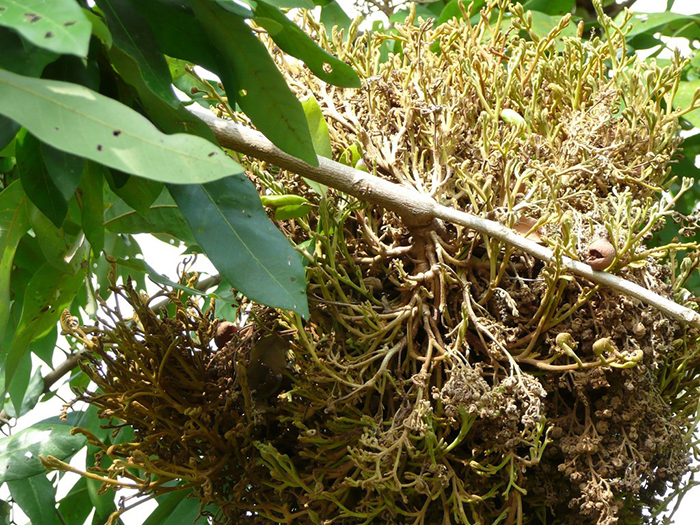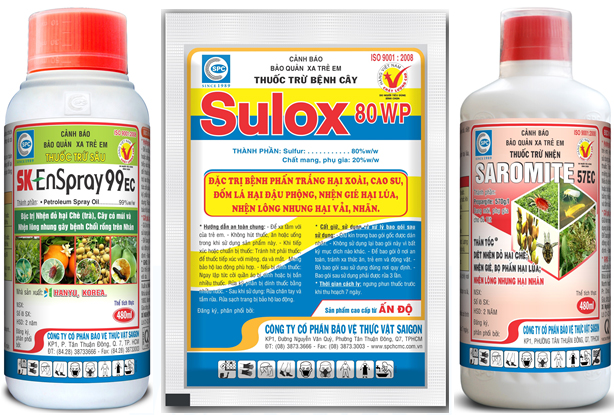|
Witches broom disease and prevention
19/01/2022
MSc Huynh Kim Ngoc “Witches Broom “disease also known as "shrinkled top", "ruffled top", "unicorn head"... has just appeared (about 2003), at first the disease appeared and caused scattered damage in the Southeast, however, Recently in the Mekong Delta, the disease has spread on the largest scale in Dong Thap, Tien Giang, Vinh Long, and Tra Vinh. The disease causes severe damage to productivity, there is no specific treatment and prevention is the main thing. Disease symptoms: Witches Broom disease causes damage on young shoots and inflorescences causing these parts not to develop, reducing the ability to set flowers, fruit, poor quality fruit, and loss of yield. Symptoms of witches broom disease are easy to identify: The diseased young shoots grow in clusters with many small, short, deformed,twisted branches, The diseased branch shrinks to look like a bunch of brooms, so people call it witches broom" Diseased inflorescences also have similar symptoms, underdeveloped inflorescences, short inflorescence, petals do not unfold but shrink, bright color, very low fruit setting rate, fruit if beans do not develop, dry gradually and die. Witches broom disease ease can appear anywhere on the longan tree, quickly spreads throughout the garden, the diseased tree develops normally, but the diseased buds do not develop but gradually degenerate. The disease causes damage all year round, but it is most severe in the dry season, the disease is common in thick planted gardens, dense canopy, unbalanced fertilizer application, high nitrogen fertilization, garden lacks water in the dry season, poor hygiene and garden care.
Agent: So far, the causative agent of "witches broom" is not unified, some people think it is Phycoplasma, another author thinks it is a virus, recently some researchers think the cause is bacteria, however. The disease is closely related to spiders and sucking insects. According to research by many domestic and foreign authors, the disease is closely related to the villous spider (Eriophyes litchii) and this is the vector that transmits the witches broom disease. Eriophyes are difficult to identify due to their very small size, yellow-white body, 2 pairs of legs on the thorax, and hairy tail. Life cycle 8 - 15 days, a year with 13 - 15 litters, spiders appear and cause damage in the dry season. Spider stings suck mainly on young parts such as buds, shoots, newly bloomed flower clusters, but when there are no buds, spiders suck old parts. How to prevent: - Planting resistant varieties, if the area is under high disease pressure,it is recommended to graft scion of xuong longan with yellow pulp into the rootstock of cowhide colored small seeded longan (strong vitality, but seriously infected disease) or long longan, ...xuong longan with white pulp - Using disease-free plants as propagating materials. Avoid transporting planting material from an infected area to another. - Sufficient watering, reasonable fertilization, avoiding excessive nitrogen fertilization to make the leaves develop and produce leaves is not concentrated, creating favorable conditions for the disease to develop.. - Pruning branches to create canopy to create conditions for concentrated flowering, uniform, favorable for disease management. - Pruning branches after harvest. Should be pruned deeply (pruning below the diseased location over 50 cm to remove diseased branches, harmful spiders... should cut off branches close to the ground). - Visiting the garden regularly, when detecting diseases, should be removed and destroyed immediately. Care should be taken to clean pruning tools to avoid the spread of disease. Combine pruning to handle flowering longan with control of villous spiders by spraying when the plants just sprouting and flowering such as: Sulox 80WP, Saromite 57EC, SK 99EC mineral oil. Pay attention to spray a lot of water, focus on the young parts of the plant, spray once every 7-10 days, in addition, because harmful spiders are resistant to products quickly, so it is recommended to rotate the product.
|
To prevent, in addition to plowing and burying weed seeds, collecting weed stalks and stumps left after tilling the land to burn, not letting weeds produce seeds in production fields, etc., the use of chemical products is still a measure. optimal because of its ability to thoroughly kill weeds, reduce labor and take advantage of more time than manual weeding.
Miner has the scientific name Phyllocnistis citrella Staint., family Phyllocnistidae, order Lepidoptera. The miner occurs in many countries in the tropics and subtropics. The main host of the miner is the citrus family - Rutaceae. In addition, the miner also attacks mangosteen and some other plants.
Adult is a small planthopper, with a body 2-3 mm long, the whole body is ash gray, slightly greenish, the wings are opaque with many small brown spots.Eggs are oval, 0.3 mm long, have a pointed end and are attached directly to the leaf surface, leaf axils.
Green bugs specialize in the fruit of citrus groups (oranges, tangerines, lemons, grapefruits, kumquats...), some people call them orange bugs, or orange suckers. Their scientific name is Rhynchocoris poseidon or Rhynchocoris humeralis.
In Vietnam, yellow leaf curl disease is very common on papaya trees, especially the disease is often severe in areas of high and continuous planting, areas with hot and arid climates. The disease has significantly reduced the yield and quality of papaya. Gardens that are infected early when the plants are young may not yield. However, up to now, many gardeners still do not know the cause and how to fix it.
Spider mites are common pests on citrus trees, especially in hot and dry climates that are suitable for spiders to grow and cause severe damage.The group of harmful spiders is usually very small in size, unlike the natural enemy spiders.
This group includes species that are generally very small in size, causing damage by sucking plant sap (on leaves, fruits, branches, stems).
There are many species of mealybugs present on the group of Oranges,Tangerines,Grapefruits and Lemons (Citrus), which can be divided into 2 groups:
+ Group of sticky mealybugs with common varieties such as Lepidosaphes, Aonidiella, Coccus and Saissetia.
+ Group of flower mealybugs with common genera and species such as Pseudococcus, Planococcus and Icerya purchasi.
Dry branches and berries disease often appear to be common damage on coffee gardens during the rainy season. The disease causes death of branchs, dry fruit, severely affects the canopy structure and coffee yield if not paid attention to prevention.
Pink disease commonly causes diseases on rubber plantations in the rainy season, especially on garden from 4-8 years old. This year, rubber has to go through a period of severe drought, weakening the tree, so now in tnshe rainy season it is easy to get infected. Therefore, it is necessary to pay attention to good management to avoid affecting the garden.
In recent years, the area of citrus has been expanded because it is a fruit tree with high economic efficiency. However, in order to sell at a high price, not only in quality but consumers also require the external beauty of the fruit, so pest management on citrus is a matter of great concern to farmers. The hot season is a favorable condition for thrips to develop and cause damage, affecting the commercial value of fruit.
- Headquarters
- SAIGON PLANT PROTECTION JOINT STOCK COMPANY
- RQ 1, Nguyen Van Quy St., Tan Thuan Ward, HCM City
- Tax code: 0300632232
- Tel: (028) 38 733 295 - 38 732 077
- Fax: (028) 38 733 003 - 38 733 391
- Website: www.spchcmc.vn - Email: info@spchcmc.vn
- SAIGON PLANT PROTECTION COMPANY
- SAIGON PLANT PROTECTION JOINT STOCK ENTERPRISE
- Lot C1-C3 Hiep Phuoc Industrial Park, Hiep Phuoc Commune, HCM City
- Tel: (028) 3873 4089 - Fax: (028) 3873 4086
- Affiliated Unit
-
- Quick Links
- Home
- About us
- Career Opportunities













